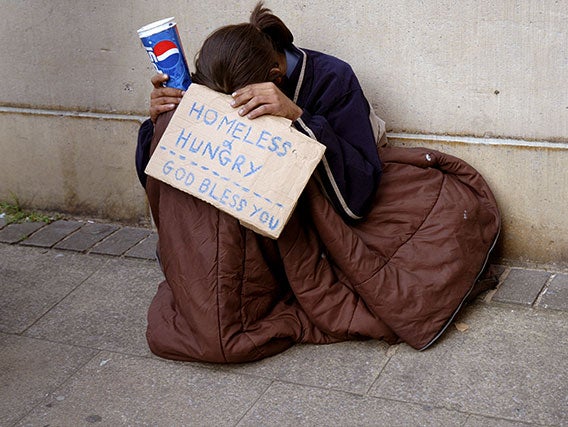Government accused of neglecting women rough sleepers by dramatically undercounting them
Exclusive: ‘You have to be visible to get the help but you also need to be invisible to keep safe,’ former rough sleeper says

The government has been accused of neglecting the needs of homeless women by dramatically undercounting the numbers sleeping rough.
The first national census of women sleeping rough, shared exclusively with The Independent, found there are 43 per cent more women living on the streets in England than the official government data suggests.
Researchers counted 815 women sleeping rough in 41 local authorities across England - substantially higher than the government figure of 568 from last year.
Campaigners warn of a “gender bias” in government figures due to data teams only counting those who are “bedded down” or “about to bed down” as sleeping rough - saying many homeless women avoid sleeping in public spaces due to the risk of sexual violence.
The first-of-its-kind research, by a coalition of prominent women’s and homelessness organisations, counted women sleeping rough in “hidden” places that women report sleeping in, with this including buses and trains, A&E waiting rooms, squats, walking around all night, and sofa-surfing with strangers.
However, researchers say the figures may still not capture the true numbers.
A former rough sleeper told The Independent: “You have to be visible to get the help but you also need to be invisible to keep safe”.
I always remember a woman once said: ‘I’d rather be raped by the same person every night than by a different person every night’.
Researchers found sharp discrepancies in some areas - counting 188 women sleeping rough in Greater Manchester while government data recorded only five women being street homeless there.
The study, by Solace and Single Homeless Project among others, found the number of women sleeping rough in London was more than twice as high as the government figures - with researchers counting 391 female rough sleepers and the government data recording 159.
Lucy Campbell, of Single Homeless Project, said women often struggle to get help from frontline services or receive accommodation referrals due to sleeping in hidden spots or not sleeping at all due to being too scared.
“What we see is a massive prevalence of domestic abuse within the couples who are experiencing street homelessness,” she added. “I always remember a woman once said: ‘I’d rather be raped by the same person every night than by a different person every night’.”
Ms Campbell argued there is no safe way for women to rough sleep but doing so “alone in an exposed way” is likely to be the most dangerous.
She noted female rough sleepers die even younger than men on the streets, adding the average age to die is 43 - around half the age of a woman in the wider population.
Eleanor Greenhalgh, of Solace, said female rough sleepers they interviewed say they often got into relationships with men on the streets to stay safe, as well as accepting accommodation from strangers who it later transpires are abusive and exploitative.
Researchers are calling for the government to urgently overhaul the way female rough sleepers are counted in data and tackle the barriers to support homeless women face.
Maxine Brown told The Independent she was first pushed into sleeping rough for a few months after running away at the age of 14 because her mother was attacking her.
“I just ran and I ran and I ran,” the now 55-year-old, from London, recalled. “I was just overwhelmed with being scared of people. I just had the clothes that I had on.”
She walked around during the day and went to the top floor of a tower block at night but barely slept due to remaining hyper-vigilant at all times, she added.

“You try not to be visible,” she said. “But yet you want to be visible because you want somebody to notice you so that you can get some kind of help. But you don’t know what kind of help you need.”
Ms Brown recalled a man offering to give her £5 if she were to lift up her skirt. “Being vulnerable and scared, people saw that in me,” she added.
The mother-of-two estimated she was street homeless for around six months of her life - explaining she became homeless again at 37 due to an addiction to crack cocaine which went on for 23 years.
Ms Brown explained she was placed in supported accommodation before being properly housed in 2006 and then getting clean from the drug crack in 2010. She now juggles helping other women in similar situations to her own with a part-time job.
“Instead of buying crack cocaine on a Monday, I bought flowers for myself and I learnt to shop instead of shoplifting,” she said.
A spokesperson for the Levelling Up, Housing and Communities department said: “We are working closely with the group behind the Women’s Rough Sleeping Census and have promoted the census to all local authorities.
“We know that women sleeping rough need specific support, which is why we are working with charities on the census to give better information to help women off the streets.”
Join our commenting forum
Join thought-provoking conversations, follow other Independent readers and see their replies
Comments
Bookmark popover
Removed from bookmarks